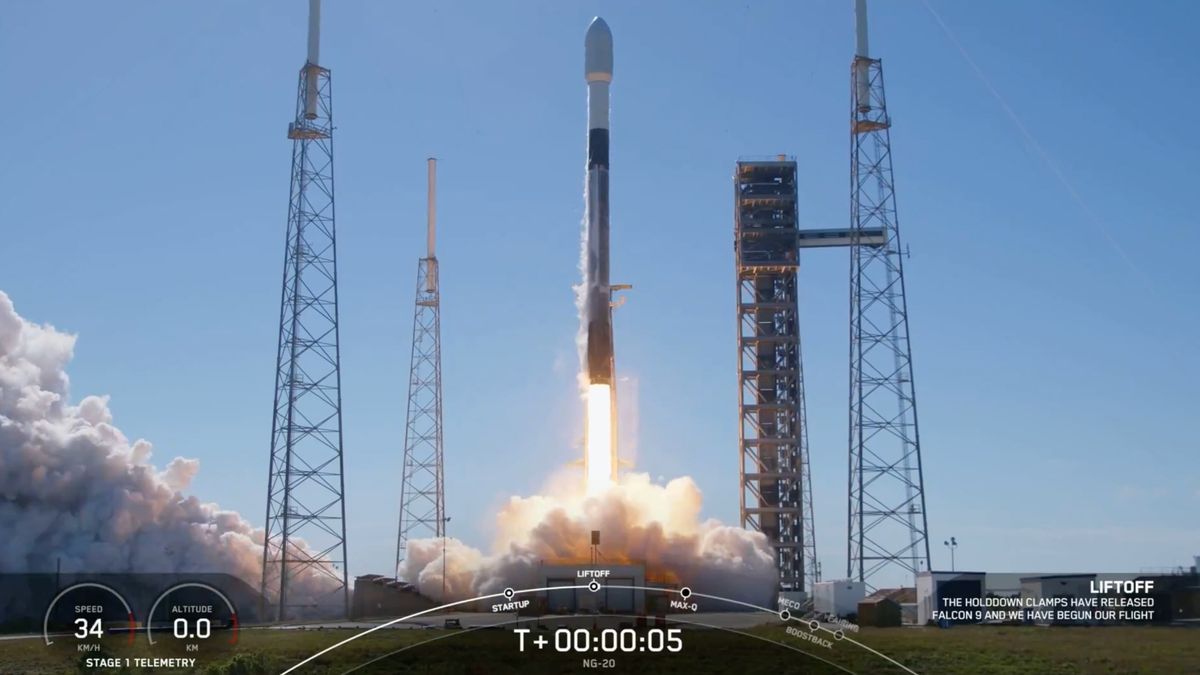SpaceX launched Northrop Grumman’s robotic Cygnus spacecraft today (Jan. 30), sending the freighter and its 4 tons of cargo toward the International Space Station.
The Cygnus lifted off atop a Falcon 9 rocket from Cape Canaveral Space Force Station in Florida today at 12:07 p.m. EST (1707 GMT).
The launch kicked off the 20th operational cargo mission for Cygnus. SpaceX was not involved in the previous 19; they all lifted off atop Antares or Atlas V rockets.
Related: Facts about Cygnus, Northrop Grumman’s cargo ship
The Falcon 9’s first stage returned to Earth as planned today, acing its touchdown at Cape Canaveral about 8 minutes and 20 seconds after launch. It was the 10th launch and landing for this particular booster, according to a SpaceX mission description.
The Cygnus, meanwhile, deployed from the Falcon 9’s upper stage in low Earth orbit around 14 minutes and 45 seconds after launch. The freighter then began making its own way to the International Space Station (ISS).
If all goes according to plan, Cygnus will arrive at the orbiting lab at 4:20 a.m. EST (0920 GMT) on Thursday (Feb. 1). You can watch its rendezvous and docking activities live here at Space.com, courtesy of NASA.

Northrop Grumman named this Cygnus vehicle after Patty Hilliard Robertson, a NASA astronaut who died in a private plane crash in 2001. She was selected to the astronaut corps in 1998 and was supposed to fly to the ISS in 2022.
The freighter is packed with more than 8,200 pounds (3,720 kilograms) of supplies and scientific hardware. Among the research gear is a cartilage-growing experiment that could help address joint damage and disease here on Earth and a European Space Agency project that will test the 3D printing of metals in microgravity.
You can learn more about this cargo mission, called NG-20, via NASA’s overview.
Cygnus will spend about six months docked to the ISS, then head back down for a fiery destruction in Earth’s atmosphere.
One experiment aboard Cygnus, called the Kentucky Re-entry Probe Experiment-2, will gather data during this death dive, taking “measurements to demonstrate a thermal protection system for spacecraft and their contents during re-entry in Earth’s atmosphere, which can be difficult to replicate in ground simulations,” NASA officials wrote in their NG-20 mission overview.
Cygnus is one of three robotic cargo craft that currently service the ISS, along with SpaceX’s Dragon capsule and Russia’s Progress vehicle. Progress, like Cygnus, is an expendable spacecraft, but Dragon is reusable, surviving the trip through Earth’s atmosphere and splashing down softly under parachutes in the ocean.

Dr. Thomas Hughes is a UK-based scientist and science communicator who makes complex topics accessible to readers. His articles explore breakthroughs in various scientific disciplines, from space exploration to cutting-edge research.







